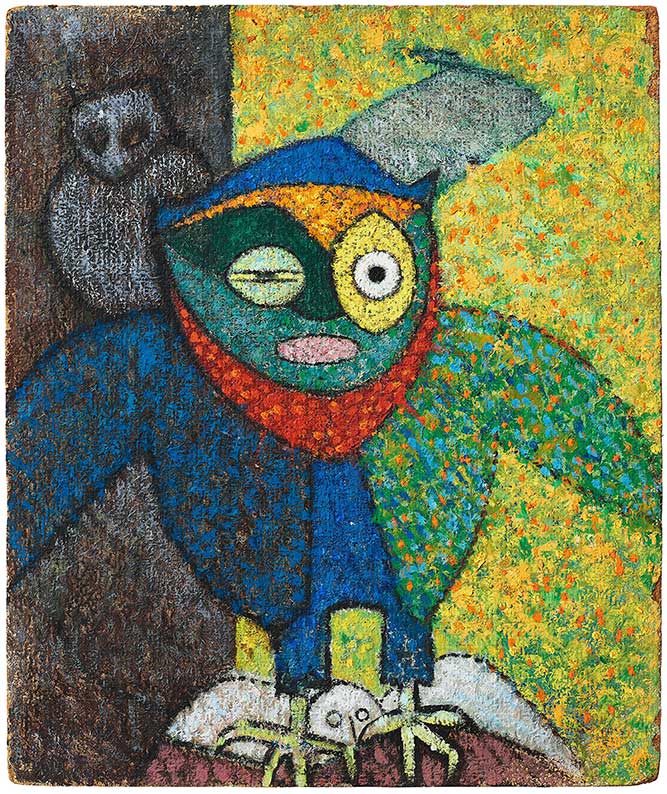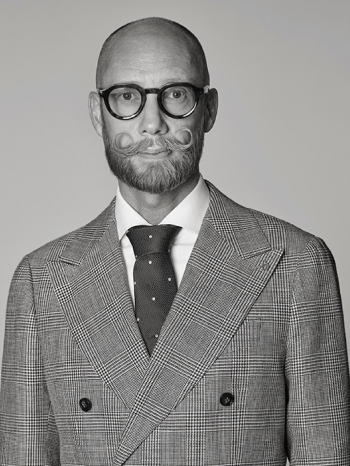Anniversary auctions at Bukowskis presenting Max Ernst
Bukowskis presents 'The Joker' by Max Ernst on the autumn anniversary auction Modern Art + Design.
Max Ernst is counted amongst the most important and innovative artists of the 20th century. Early in his career he was involved with the Cologne Dadaists and later became one of the key figures in the Surrealist movement. He was ahead of his time in challenging the conventions of painting. Ernst painted instinctively and primitively, perhaps like a modern shaman whose creativity is steeped in rituals and mysticism.
Ernst’s development of the frottage technique came to play a central role in his artistic practice. The discovery happened on a rainy day in 1925, when he found himself alone in a hotel room in Pornic, France. In his biographical notes, published in Beyond Painting, and also reproduced in Moderna Museet’s catalogue for the major 1969 exhibition of Max Ernst’s work, he describes the moment:
“[…] in order to aid my meditative and hallucinatory faculties, I made from the boards a series of drawings by placing on them, at random, sheets of paper which I undertook to rub with black lead. In gazing attentively at the drawings thus obtained […] I was surprised by the sudden intensification of my visionary capacities […] My curiosity awakened and astonished, I began to experiment indifferently and to question, utilizing the same means, all sorts of material to be found in my visual field: leaves and their veins, the ragged edges of a bit of linen, the brushstrokes of a '“modern'” painting, the unwound thread from a spool, etc. […] I insist on the fact that the drawings thus obtained lost more and more, through a series of suggestions and transmutations that offered themselves spontaneously – in the manner of that which passes for hypnagogic visions – the character of the material interrogated (the wood, for example) and took on the aspect of images of an unhoped-for precision, probably of a sort which revealed the first cause of the obsession, or produced a simulacrum of that cause.”
(Ernst 1948, p.7)

The method gave Ernst’s art an entirely novel expression and became a source of new motifs for him. He executed a series of works on paper and a few years later further developed the technique through his so-called ‘grattage’ – an application of the frottage technique but in painting. In these he primed a surface (for example a canvas or a paper) with thin layers of paint, which was then placed on top of an object. Using a palette knife he scraped off the paint, resulting in new images forming through the underlying objects’ structures. In Ernst’s imagination the central figures were often birdlike hybrids with human bodies or hands, symbols of freedom with supernatural qualities. Ernst created an alter-ego, Lop Lop, ‘King of the Birds’, who first appears in a series of paintings and collages from the end of the 1920s and embodies Ernst himself, a primitive icon bearing the secrets to visionary freedom. Lop Lop’s origin can be traced to a confusing episode from his childhood when his beloved pet parrot Hornebom died at the moment of his little sister Loni’s birth. The young Max Ernst mistook his sister for the reincarnation of the parrot. With this in mind Lop Lop operates as a fanciful creature born through death, a spiritual emblem, a guide through the ghostly strata of Ernst’s inner mind.
The present work, The Joker or Le Farceur, was begun in 1950 and first included in Max Ernst Oeuvre-Katalog, vol. 5, Werke 1939-1953 as an untitled piece with the catalogue number 282. Ernst later enhanced the work with a winged body with bird claws, an owl on the shoulder, and a white bird with its wings extended above the claws. The painting was finished in 1957 and is included in the Catalogue Raisonné, with the catalogue number 283.
When is the viewing and auction?
Bukowskis Modern Art + Design
Viewing 19 – 23 November, Berzelii Park 1, Stockholm, Opening hours: Mon–Fri kl 11–18, Sat–Sun kl 11–17
Auction 24 – 25 November, Arsenalsgatan 2, Stockholm
Contact our specialists






























